Implementing Changes in Existing Education Systems
VerifiedAdded on 2021/04/21
|9
|2137
|72
AI Summary
The assignment emphasizes the need for a structured approach to implement changes in education systems. It highlights the significance of understanding student learning histories, development levels, skills, and expectations. The importance of providing ample support to learners and teachers is also stressed, along with the need for proper training and pilot testing before implementation. The document aims to provide insights into effective ways to engage students in their learning process.
Contribute Materials
Your contribution can guide someone’s learning journey. Share your
documents today.
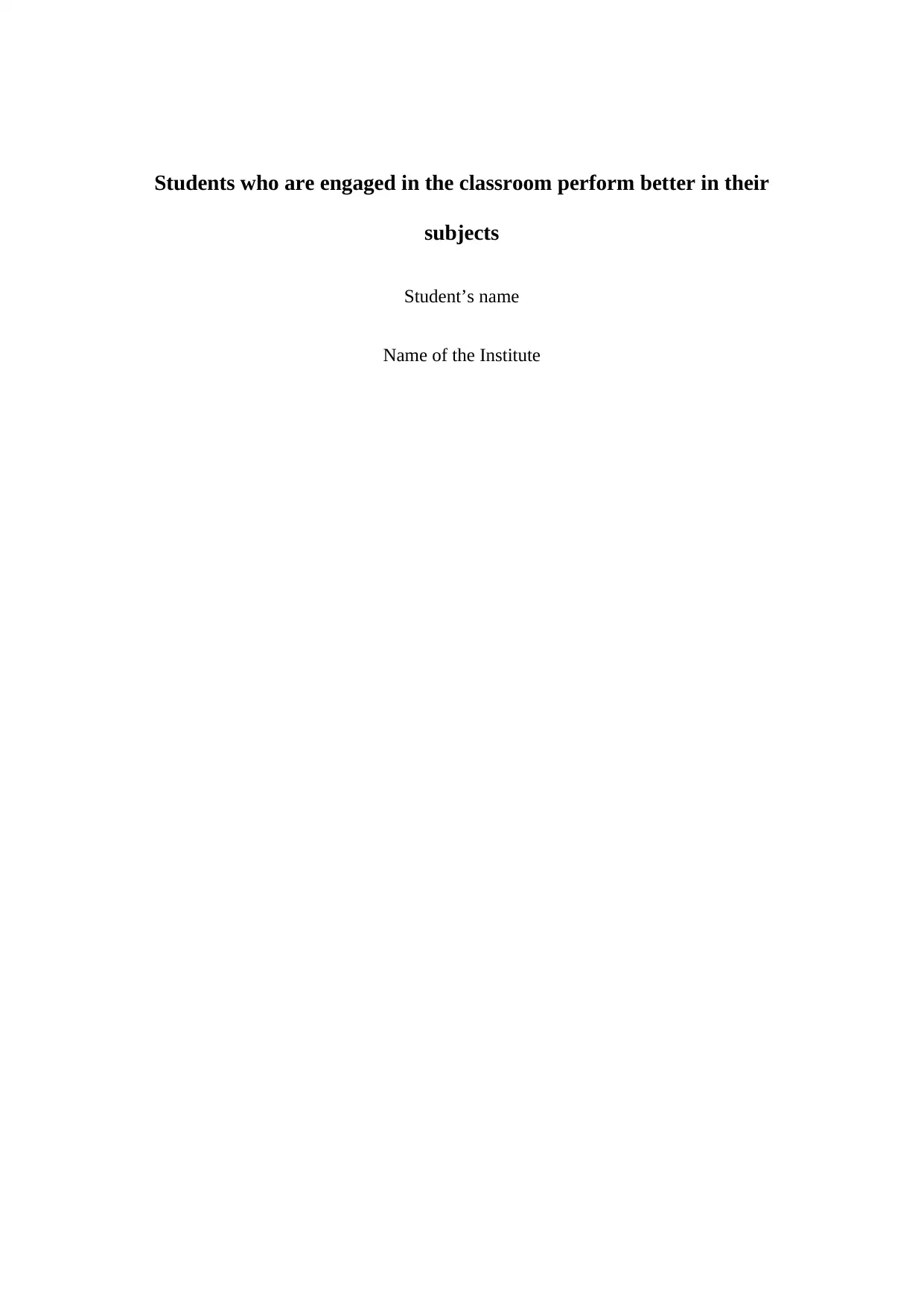
Students who are engaged in the classroom perform better in their
subjects
Student’s name
Name of the Institute
subjects
Student’s name
Name of the Institute
Secure Best Marks with AI Grader
Need help grading? Try our AI Grader for instant feedback on your assignments.
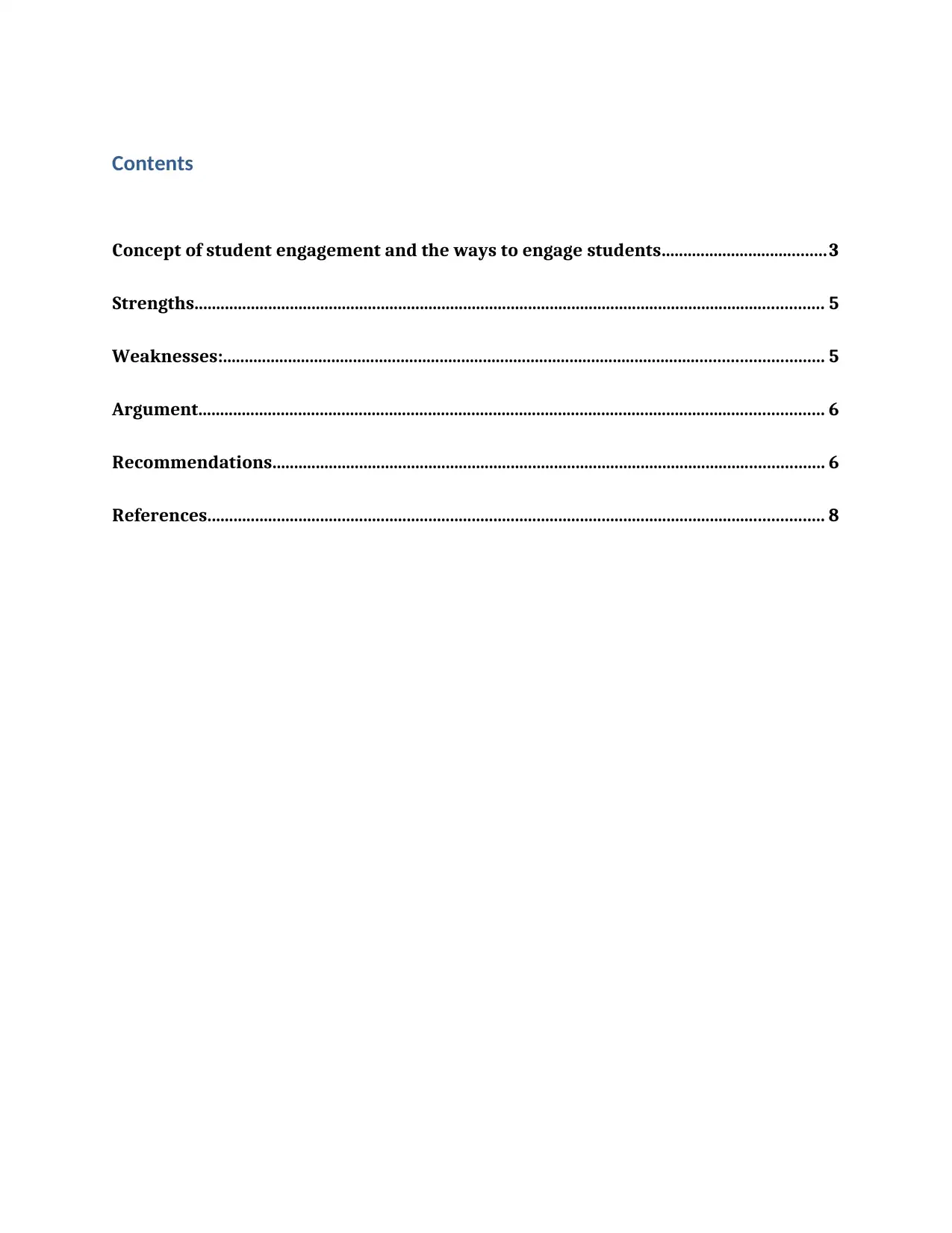
Contents
Concept of student engagement and the ways to engage students......................................3
Strengths................................................................................................................................................. 5
Weaknesses:.......................................................................................................................................... 5
Argument................................................................................................................................................ 6
Recommendations............................................................................................................................... 6
References.............................................................................................................................................. 8
Concept of student engagement and the ways to engage students......................................3
Strengths................................................................................................................................................. 5
Weaknesses:.......................................................................................................................................... 5
Argument................................................................................................................................................ 6
Recommendations............................................................................................................................... 6
References.............................................................................................................................................. 8
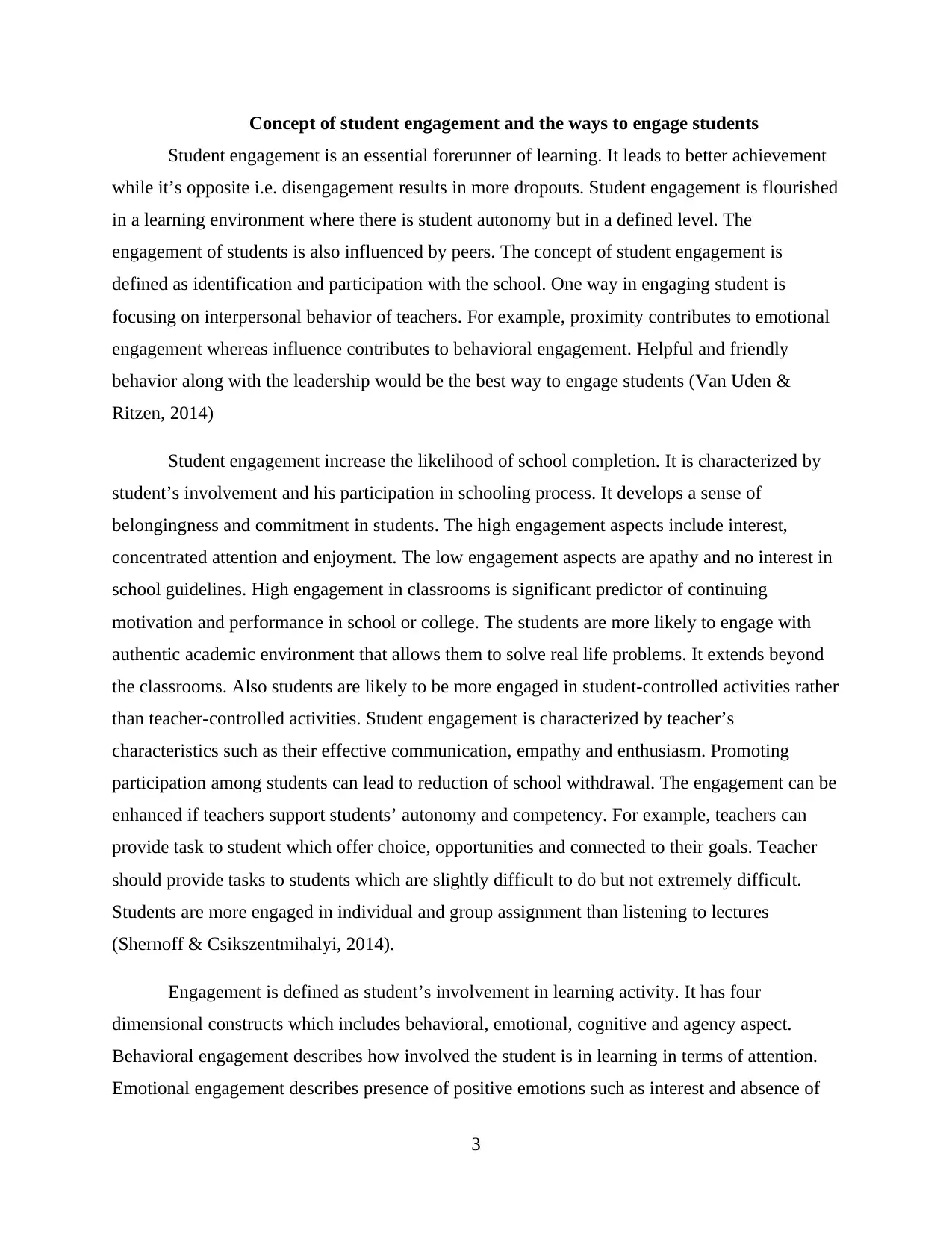
Concept of student engagement and the ways to engage students
Student engagement is an essential forerunner of learning. It leads to better achievement
while it’s opposite i.e. disengagement results in more dropouts. Student engagement is flourished
in a learning environment where there is student autonomy but in a defined level. The
engagement of students is also influenced by peers. The concept of student engagement is
defined as identification and participation with the school. One way in engaging student is
focusing on interpersonal behavior of teachers. For example, proximity contributes to emotional
engagement whereas influence contributes to behavioral engagement. Helpful and friendly
behavior along with the leadership would be the best way to engage students (Van Uden &
Ritzen, 2014)
Student engagement increase the likelihood of school completion. It is characterized by
student’s involvement and his participation in schooling process. It develops a sense of
belongingness and commitment in students. The high engagement aspects include interest,
concentrated attention and enjoyment. The low engagement aspects are apathy and no interest in
school guidelines. High engagement in classrooms is significant predictor of continuing
motivation and performance in school or college. The students are more likely to engage with
authentic academic environment that allows them to solve real life problems. It extends beyond
the classrooms. Also students are likely to be more engaged in student-controlled activities rather
than teacher-controlled activities. Student engagement is characterized by teacher’s
characteristics such as their effective communication, empathy and enthusiasm. Promoting
participation among students can lead to reduction of school withdrawal. The engagement can be
enhanced if teachers support students’ autonomy and competency. For example, teachers can
provide task to student which offer choice, opportunities and connected to their goals. Teacher
should provide tasks to students which are slightly difficult to do but not extremely difficult.
Students are more engaged in individual and group assignment than listening to lectures
(Shernoff & Csikszentmihalyi, 2014).
Engagement is defined as student’s involvement in learning activity. It has four
dimensional constructs which includes behavioral, emotional, cognitive and agency aspect.
Behavioral engagement describes how involved the student is in learning in terms of attention.
Emotional engagement describes presence of positive emotions such as interest and absence of
3
Student engagement is an essential forerunner of learning. It leads to better achievement
while it’s opposite i.e. disengagement results in more dropouts. Student engagement is flourished
in a learning environment where there is student autonomy but in a defined level. The
engagement of students is also influenced by peers. The concept of student engagement is
defined as identification and participation with the school. One way in engaging student is
focusing on interpersonal behavior of teachers. For example, proximity contributes to emotional
engagement whereas influence contributes to behavioral engagement. Helpful and friendly
behavior along with the leadership would be the best way to engage students (Van Uden &
Ritzen, 2014)
Student engagement increase the likelihood of school completion. It is characterized by
student’s involvement and his participation in schooling process. It develops a sense of
belongingness and commitment in students. The high engagement aspects include interest,
concentrated attention and enjoyment. The low engagement aspects are apathy and no interest in
school guidelines. High engagement in classrooms is significant predictor of continuing
motivation and performance in school or college. The students are more likely to engage with
authentic academic environment that allows them to solve real life problems. It extends beyond
the classrooms. Also students are likely to be more engaged in student-controlled activities rather
than teacher-controlled activities. Student engagement is characterized by teacher’s
characteristics such as their effective communication, empathy and enthusiasm. Promoting
participation among students can lead to reduction of school withdrawal. The engagement can be
enhanced if teachers support students’ autonomy and competency. For example, teachers can
provide task to student which offer choice, opportunities and connected to their goals. Teacher
should provide tasks to students which are slightly difficult to do but not extremely difficult.
Students are more engaged in individual and group assignment than listening to lectures
(Shernoff & Csikszentmihalyi, 2014).
Engagement is defined as student’s involvement in learning activity. It has four
dimensional constructs which includes behavioral, emotional, cognitive and agency aspect.
Behavioral engagement describes how involved the student is in learning in terms of attention.
Emotional engagement describes presence of positive emotions such as interest and absence of
3
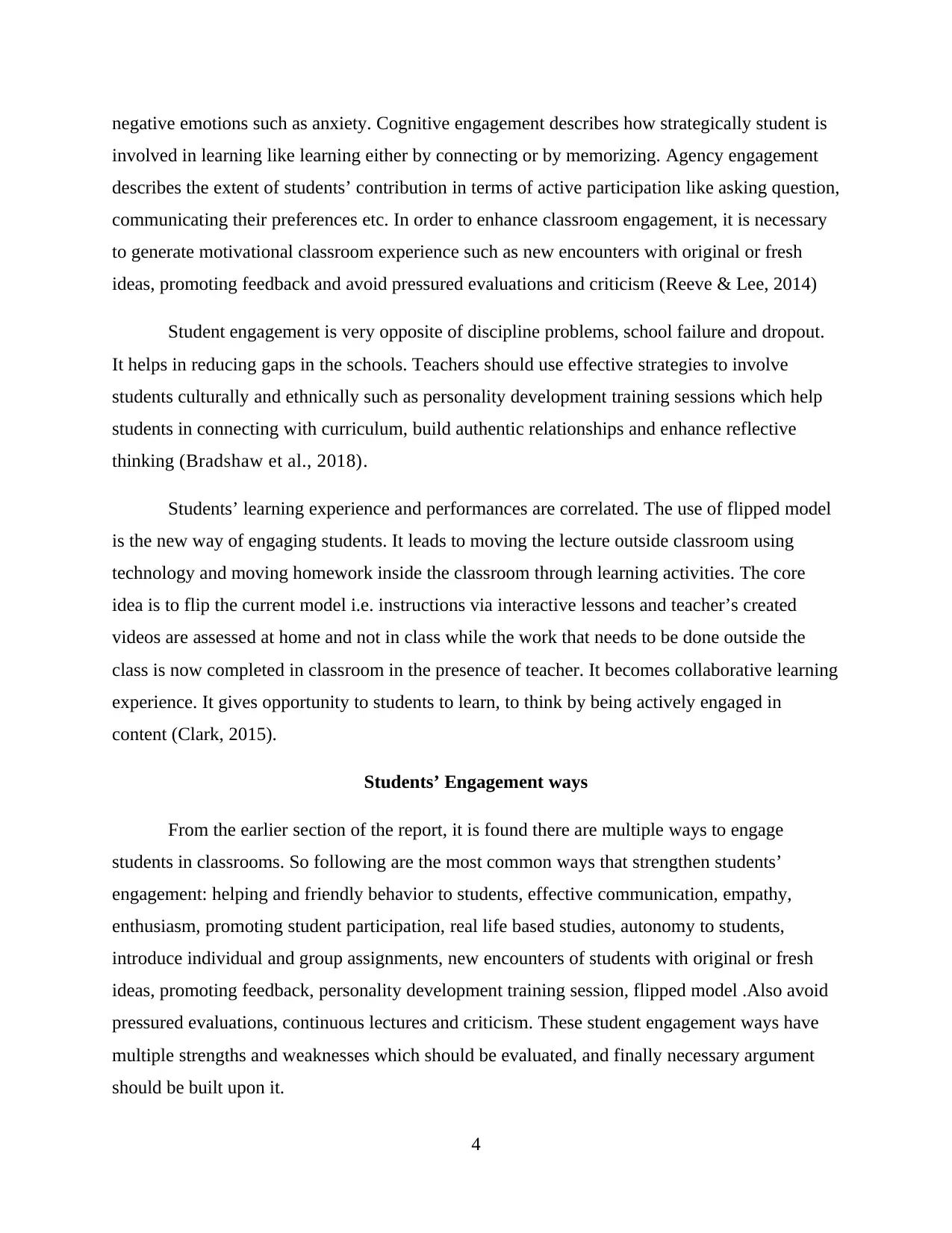
negative emotions such as anxiety. Cognitive engagement describes how strategically student is
involved in learning like learning either by connecting or by memorizing. Agency engagement
describes the extent of students’ contribution in terms of active participation like asking question,
communicating their preferences etc. In order to enhance classroom engagement, it is necessary
to generate motivational classroom experience such as new encounters with original or fresh
ideas, promoting feedback and avoid pressured evaluations and criticism (Reeve & Lee, 2014)
Student engagement is very opposite of discipline problems, school failure and dropout.
It helps in reducing gaps in the schools. Teachers should use effective strategies to involve
students culturally and ethnically such as personality development training sessions which help
students in connecting with curriculum, build authentic relationships and enhance reflective
thinking (Bradshaw et al., 2018).
Students’ learning experience and performances are correlated. The use of flipped model
is the new way of engaging students. It leads to moving the lecture outside classroom using
technology and moving homework inside the classroom through learning activities. The core
idea is to flip the current model i.e. instructions via interactive lessons and teacher’s created
videos are assessed at home and not in class while the work that needs to be done outside the
class is now completed in classroom in the presence of teacher. It becomes collaborative learning
experience. It gives opportunity to students to learn, to think by being actively engaged in
content (Clark, 2015).
Students’ Engagement ways
From the earlier section of the report, it is found there are multiple ways to engage
students in classrooms. So following are the most common ways that strengthen students’
engagement: helping and friendly behavior to students, effective communication, empathy,
enthusiasm, promoting student participation, real life based studies, autonomy to students,
introduce individual and group assignments, new encounters of students with original or fresh
ideas, promoting feedback, personality development training session, flipped model .Also avoid
pressured evaluations, continuous lectures and criticism. These student engagement ways have
multiple strengths and weaknesses which should be evaluated, and finally necessary argument
should be built upon it.
4
involved in learning like learning either by connecting or by memorizing. Agency engagement
describes the extent of students’ contribution in terms of active participation like asking question,
communicating their preferences etc. In order to enhance classroom engagement, it is necessary
to generate motivational classroom experience such as new encounters with original or fresh
ideas, promoting feedback and avoid pressured evaluations and criticism (Reeve & Lee, 2014)
Student engagement is very opposite of discipline problems, school failure and dropout.
It helps in reducing gaps in the schools. Teachers should use effective strategies to involve
students culturally and ethnically such as personality development training sessions which help
students in connecting with curriculum, build authentic relationships and enhance reflective
thinking (Bradshaw et al., 2018).
Students’ learning experience and performances are correlated. The use of flipped model
is the new way of engaging students. It leads to moving the lecture outside classroom using
technology and moving homework inside the classroom through learning activities. The core
idea is to flip the current model i.e. instructions via interactive lessons and teacher’s created
videos are assessed at home and not in class while the work that needs to be done outside the
class is now completed in classroom in the presence of teacher. It becomes collaborative learning
experience. It gives opportunity to students to learn, to think by being actively engaged in
content (Clark, 2015).
Students’ Engagement ways
From the earlier section of the report, it is found there are multiple ways to engage
students in classrooms. So following are the most common ways that strengthen students’
engagement: helping and friendly behavior to students, effective communication, empathy,
enthusiasm, promoting student participation, real life based studies, autonomy to students,
introduce individual and group assignments, new encounters of students with original or fresh
ideas, promoting feedback, personality development training session, flipped model .Also avoid
pressured evaluations, continuous lectures and criticism. These student engagement ways have
multiple strengths and weaknesses which should be evaluated, and finally necessary argument
should be built upon it.
4
Secure Best Marks with AI Grader
Need help grading? Try our AI Grader for instant feedback on your assignments.
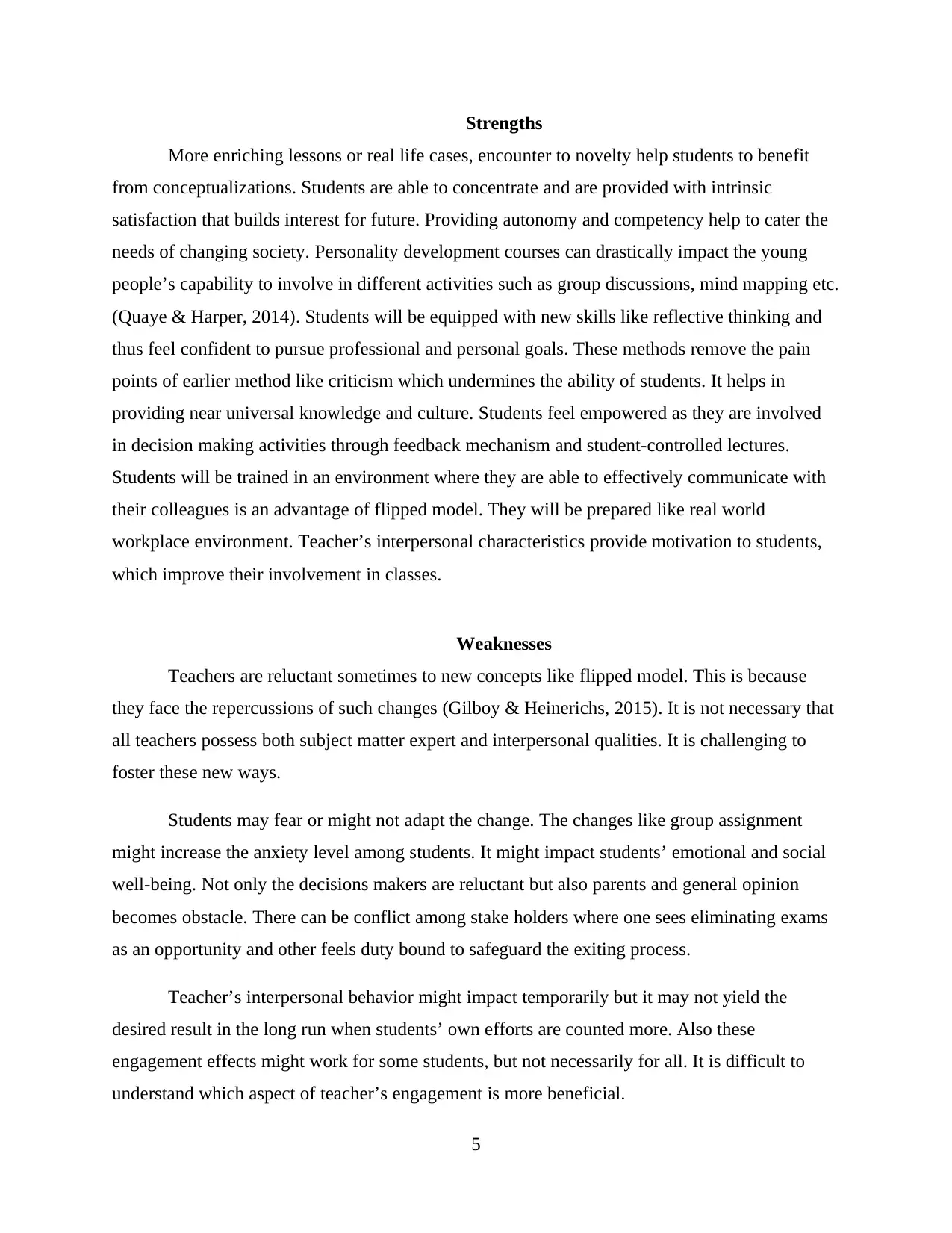
Strengths
More enriching lessons or real life cases, encounter to novelty help students to benefit
from conceptualizations. Students are able to concentrate and are provided with intrinsic
satisfaction that builds interest for future. Providing autonomy and competency help to cater the
needs of changing society. Personality development courses can drastically impact the young
people’s capability to involve in different activities such as group discussions, mind mapping etc.
(Quaye & Harper, 2014). Students will be equipped with new skills like reflective thinking and
thus feel confident to pursue professional and personal goals. These methods remove the pain
points of earlier method like criticism which undermines the ability of students. It helps in
providing near universal knowledge and culture. Students feel empowered as they are involved
in decision making activities through feedback mechanism and student-controlled lectures.
Students will be trained in an environment where they are able to effectively communicate with
their colleagues is an advantage of flipped model. They will be prepared like real world
workplace environment. Teacher’s interpersonal characteristics provide motivation to students,
which improve their involvement in classes.
Weaknesses
Teachers are reluctant sometimes to new concepts like flipped model. This is because
they face the repercussions of such changes (Gilboy & Heinerichs, 2015). It is not necessary that
all teachers possess both subject matter expert and interpersonal qualities. It is challenging to
foster these new ways.
Students may fear or might not adapt the change. The changes like group assignment
might increase the anxiety level among students. It might impact students’ emotional and social
well-being. Not only the decisions makers are reluctant but also parents and general opinion
becomes obstacle. There can be conflict among stake holders where one sees eliminating exams
as an opportunity and other feels duty bound to safeguard the exiting process.
Teacher’s interpersonal behavior might impact temporarily but it may not yield the
desired result in the long run when students’ own efforts are counted more. Also these
engagement effects might work for some students, but not necessarily for all. It is difficult to
understand which aspect of teacher’s engagement is more beneficial.
5
More enriching lessons or real life cases, encounter to novelty help students to benefit
from conceptualizations. Students are able to concentrate and are provided with intrinsic
satisfaction that builds interest for future. Providing autonomy and competency help to cater the
needs of changing society. Personality development courses can drastically impact the young
people’s capability to involve in different activities such as group discussions, mind mapping etc.
(Quaye & Harper, 2014). Students will be equipped with new skills like reflective thinking and
thus feel confident to pursue professional and personal goals. These methods remove the pain
points of earlier method like criticism which undermines the ability of students. It helps in
providing near universal knowledge and culture. Students feel empowered as they are involved
in decision making activities through feedback mechanism and student-controlled lectures.
Students will be trained in an environment where they are able to effectively communicate with
their colleagues is an advantage of flipped model. They will be prepared like real world
workplace environment. Teacher’s interpersonal characteristics provide motivation to students,
which improve their involvement in classes.
Weaknesses
Teachers are reluctant sometimes to new concepts like flipped model. This is because
they face the repercussions of such changes (Gilboy & Heinerichs, 2015). It is not necessary that
all teachers possess both subject matter expert and interpersonal qualities. It is challenging to
foster these new ways.
Students may fear or might not adapt the change. The changes like group assignment
might increase the anxiety level among students. It might impact students’ emotional and social
well-being. Not only the decisions makers are reluctant but also parents and general opinion
becomes obstacle. There can be conflict among stake holders where one sees eliminating exams
as an opportunity and other feels duty bound to safeguard the exiting process.
Teacher’s interpersonal behavior might impact temporarily but it may not yield the
desired result in the long run when students’ own efforts are counted more. Also these
engagement effects might work for some students, but not necessarily for all. It is difficult to
understand which aspect of teacher’s engagement is more beneficial.
5
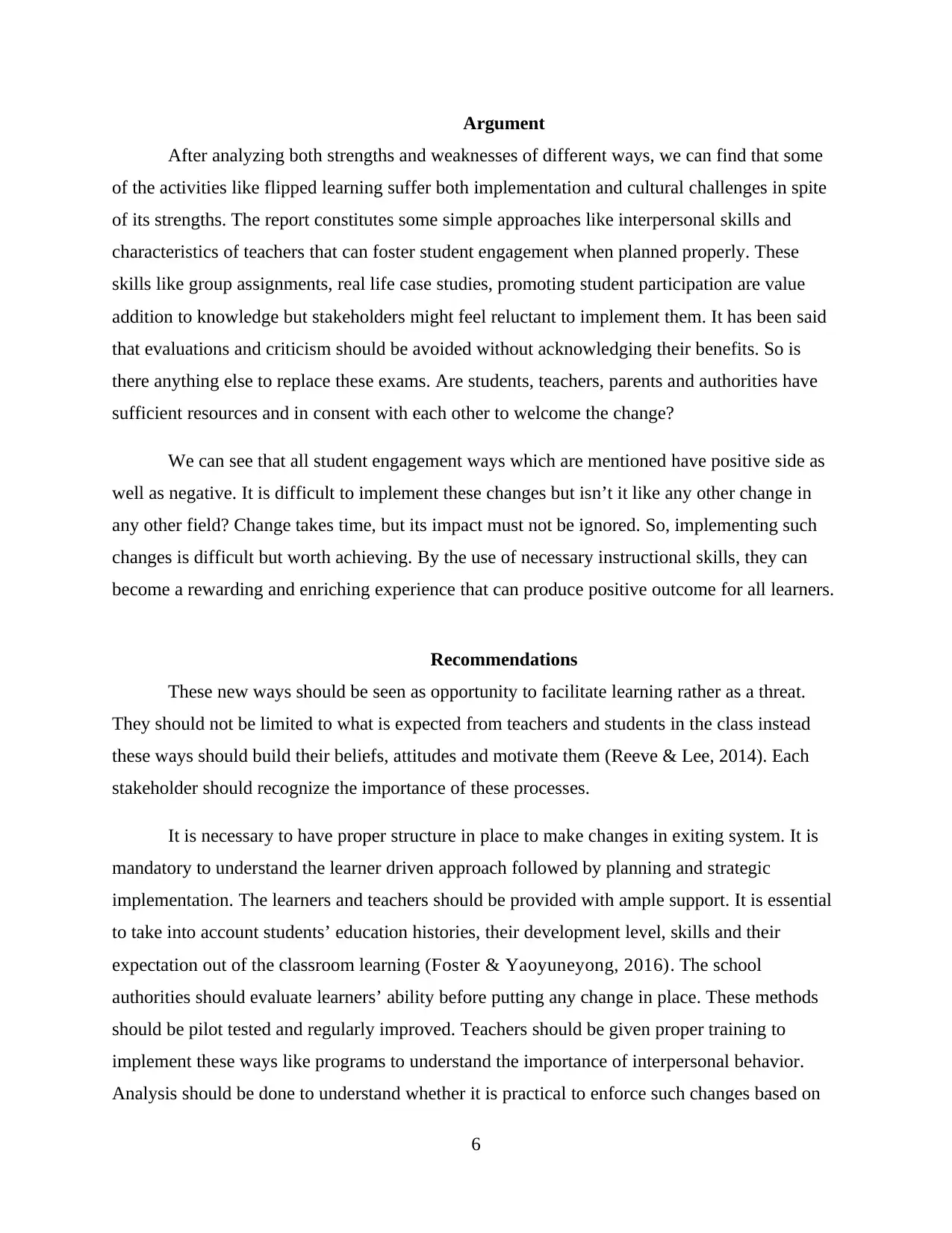
Argument
After analyzing both strengths and weaknesses of different ways, we can find that some
of the activities like flipped learning suffer both implementation and cultural challenges in spite
of its strengths. The report constitutes some simple approaches like interpersonal skills and
characteristics of teachers that can foster student engagement when planned properly. These
skills like group assignments, real life case studies, promoting student participation are value
addition to knowledge but stakeholders might feel reluctant to implement them. It has been said
that evaluations and criticism should be avoided without acknowledging their benefits. So is
there anything else to replace these exams. Are students, teachers, parents and authorities have
sufficient resources and in consent with each other to welcome the change?
We can see that all student engagement ways which are mentioned have positive side as
well as negative. It is difficult to implement these changes but isn’t it like any other change in
any other field? Change takes time, but its impact must not be ignored. So, implementing such
changes is difficult but worth achieving. By the use of necessary instructional skills, they can
become a rewarding and enriching experience that can produce positive outcome for all learners.
Recommendations
These new ways should be seen as opportunity to facilitate learning rather as a threat.
They should not be limited to what is expected from teachers and students in the class instead
these ways should build their beliefs, attitudes and motivate them (Reeve & Lee, 2014). Each
stakeholder should recognize the importance of these processes.
It is necessary to have proper structure in place to make changes in exiting system. It is
mandatory to understand the learner driven approach followed by planning and strategic
implementation. The learners and teachers should be provided with ample support. It is essential
to take into account students’ education histories, their development level, skills and their
expectation out of the classroom learning (Foster & Yaoyuneyong, 2016). The school
authorities should evaluate learners’ ability before putting any change in place. These methods
should be pilot tested and regularly improved. Teachers should be given proper training to
implement these ways like programs to understand the importance of interpersonal behavior.
Analysis should be done to understand whether it is practical to enforce such changes based on
6
After analyzing both strengths and weaknesses of different ways, we can find that some
of the activities like flipped learning suffer both implementation and cultural challenges in spite
of its strengths. The report constitutes some simple approaches like interpersonal skills and
characteristics of teachers that can foster student engagement when planned properly. These
skills like group assignments, real life case studies, promoting student participation are value
addition to knowledge but stakeholders might feel reluctant to implement them. It has been said
that evaluations and criticism should be avoided without acknowledging their benefits. So is
there anything else to replace these exams. Are students, teachers, parents and authorities have
sufficient resources and in consent with each other to welcome the change?
We can see that all student engagement ways which are mentioned have positive side as
well as negative. It is difficult to implement these changes but isn’t it like any other change in
any other field? Change takes time, but its impact must not be ignored. So, implementing such
changes is difficult but worth achieving. By the use of necessary instructional skills, they can
become a rewarding and enriching experience that can produce positive outcome for all learners.
Recommendations
These new ways should be seen as opportunity to facilitate learning rather as a threat.
They should not be limited to what is expected from teachers and students in the class instead
these ways should build their beliefs, attitudes and motivate them (Reeve & Lee, 2014). Each
stakeholder should recognize the importance of these processes.
It is necessary to have proper structure in place to make changes in exiting system. It is
mandatory to understand the learner driven approach followed by planning and strategic
implementation. The learners and teachers should be provided with ample support. It is essential
to take into account students’ education histories, their development level, skills and their
expectation out of the classroom learning (Foster & Yaoyuneyong, 2016). The school
authorities should evaluate learners’ ability before putting any change in place. These methods
should be pilot tested and regularly improved. Teachers should be given proper training to
implement these ways like programs to understand the importance of interpersonal behavior.
Analysis should be done to understand whether it is practical to enforce such changes based on
6
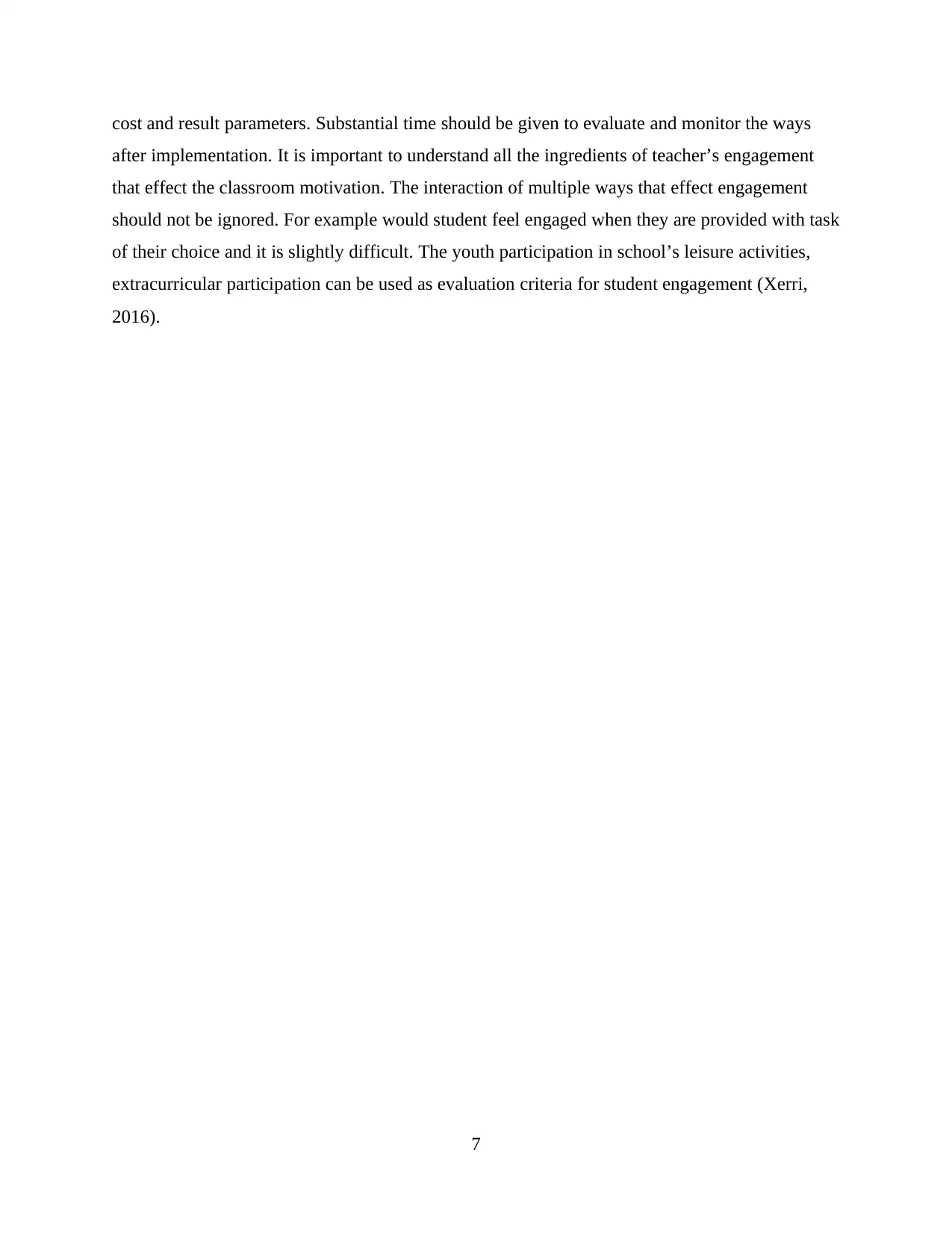
cost and result parameters. Substantial time should be given to evaluate and monitor the ways
after implementation. It is important to understand all the ingredients of teacher’s engagement
that effect the classroom motivation. The interaction of multiple ways that effect engagement
should not be ignored. For example would student feel engaged when they are provided with task
of their choice and it is slightly difficult. The youth participation in school’s leisure activities,
extracurricular participation can be used as evaluation criteria for student engagement (Xerri,
2016).
7
after implementation. It is important to understand all the ingredients of teacher’s engagement
that effect the classroom motivation. The interaction of multiple ways that effect engagement
should not be ignored. For example would student feel engaged when they are provided with task
of their choice and it is slightly difficult. The youth participation in school’s leisure activities,
extracurricular participation can be used as evaluation criteria for student engagement (Xerri,
2016).
7
Paraphrase This Document
Need a fresh take? Get an instant paraphrase of this document with our AI Paraphraser
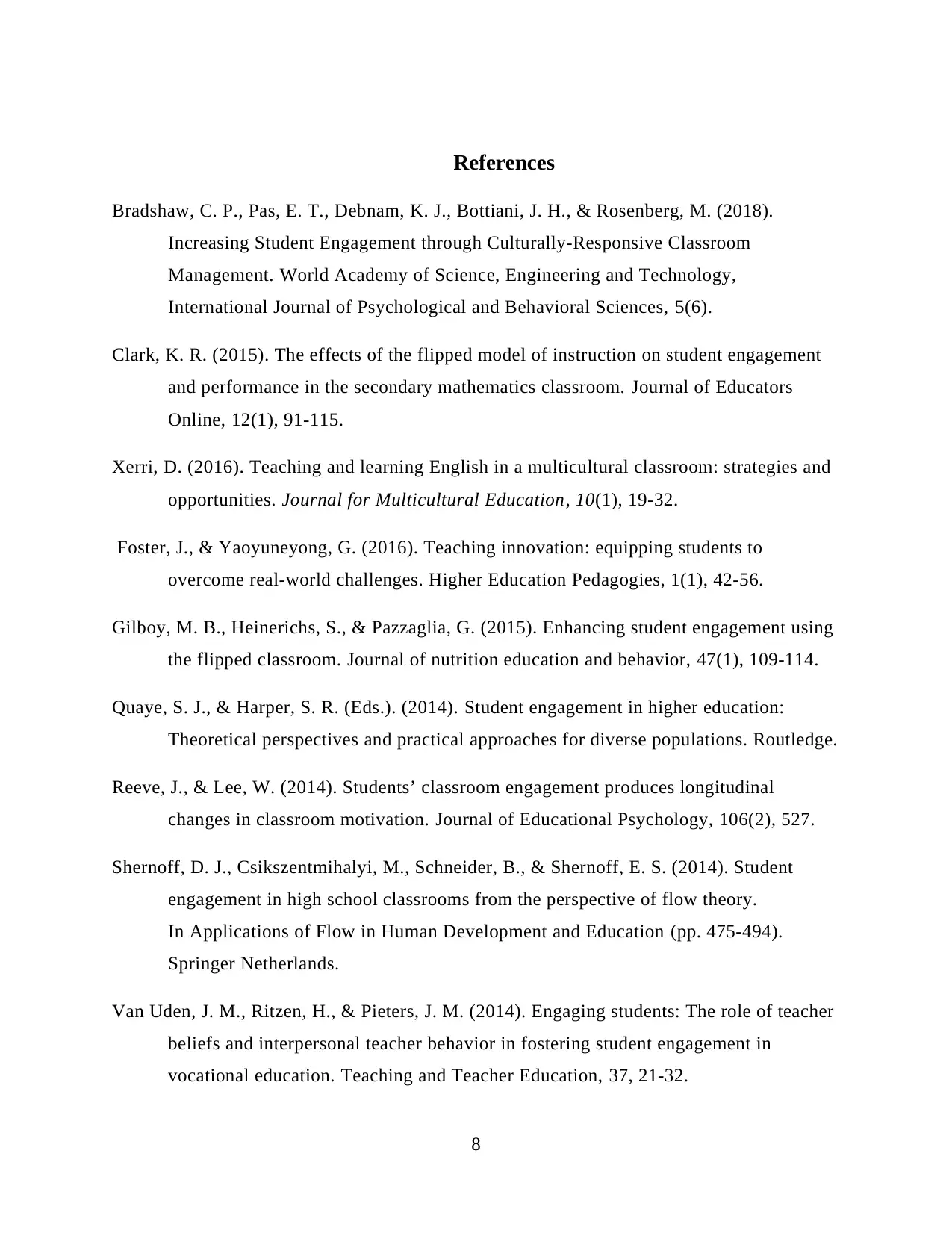
References
Bradshaw, C. P., Pas, E. T., Debnam, K. J., Bottiani, J. H., & Rosenberg, M. (2018).
Increasing Student Engagement through Culturally-Responsive Classroom
Management. World Academy of Science, Engineering and Technology,
International Journal of Psychological and Behavioral Sciences, 5(6).
Clark, K. R. (2015). The effects of the flipped model of instruction on student engagement
and performance in the secondary mathematics classroom. Journal of Educators
Online, 12(1), 91-115.
Xerri, D. (2016). Teaching and learning English in a multicultural classroom: strategies and
opportunities. Journal for Multicultural Education, 10(1), 19-32.
Foster, J., & Yaoyuneyong, G. (2016). Teaching innovation: equipping students to
overcome real-world challenges. Higher Education Pedagogies, 1(1), 42-56.
Gilboy, M. B., Heinerichs, S., & Pazzaglia, G. (2015). Enhancing student engagement using
the flipped classroom. Journal of nutrition education and behavior, 47(1), 109-114.
Quaye, S. J., & Harper, S. R. (Eds.). (2014). Student engagement in higher education:
Theoretical perspectives and practical approaches for diverse populations. Routledge.
Reeve, J., & Lee, W. (2014). Students’ classroom engagement produces longitudinal
changes in classroom motivation. Journal of Educational Psychology, 106(2), 527.
Shernoff, D. J., Csikszentmihalyi, M., Schneider, B., & Shernoff, E. S. (2014). Student
engagement in high school classrooms from the perspective of flow theory.
In Applications of Flow in Human Development and Education (pp. 475-494).
Springer Netherlands.
Van Uden, J. M., Ritzen, H., & Pieters, J. M. (2014). Engaging students: The role of teacher
beliefs and interpersonal teacher behavior in fostering student engagement in
vocational education. Teaching and Teacher Education, 37, 21-32.
8
Bradshaw, C. P., Pas, E. T., Debnam, K. J., Bottiani, J. H., & Rosenberg, M. (2018).
Increasing Student Engagement through Culturally-Responsive Classroom
Management. World Academy of Science, Engineering and Technology,
International Journal of Psychological and Behavioral Sciences, 5(6).
Clark, K. R. (2015). The effects of the flipped model of instruction on student engagement
and performance in the secondary mathematics classroom. Journal of Educators
Online, 12(1), 91-115.
Xerri, D. (2016). Teaching and learning English in a multicultural classroom: strategies and
opportunities. Journal for Multicultural Education, 10(1), 19-32.
Foster, J., & Yaoyuneyong, G. (2016). Teaching innovation: equipping students to
overcome real-world challenges. Higher Education Pedagogies, 1(1), 42-56.
Gilboy, M. B., Heinerichs, S., & Pazzaglia, G. (2015). Enhancing student engagement using
the flipped classroom. Journal of nutrition education and behavior, 47(1), 109-114.
Quaye, S. J., & Harper, S. R. (Eds.). (2014). Student engagement in higher education:
Theoretical perspectives and practical approaches for diverse populations. Routledge.
Reeve, J., & Lee, W. (2014). Students’ classroom engagement produces longitudinal
changes in classroom motivation. Journal of Educational Psychology, 106(2), 527.
Shernoff, D. J., Csikszentmihalyi, M., Schneider, B., & Shernoff, E. S. (2014). Student
engagement in high school classrooms from the perspective of flow theory.
In Applications of Flow in Human Development and Education (pp. 475-494).
Springer Netherlands.
Van Uden, J. M., Ritzen, H., & Pieters, J. M. (2014). Engaging students: The role of teacher
beliefs and interpersonal teacher behavior in fostering student engagement in
vocational education. Teaching and Teacher Education, 37, 21-32.
8

9
1 out of 9
Related Documents
Your All-in-One AI-Powered Toolkit for Academic Success.
+13062052269
info@desklib.com
Available 24*7 on WhatsApp / Email
![[object Object]](/_next/static/media/star-bottom.7253800d.svg)
Unlock your academic potential
© 2024 | Zucol Services PVT LTD | All rights reserved.





